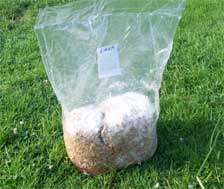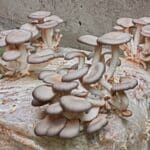Mushroom spawn is simply any substance that has been inoculated with mycelium, the vegetative growth of a fungus. Mycelium, a thread-like collection of cells, is to a mushroom-like an apple tree is to an apple. You need to have one as the base for producing the other.
The spawn is used to transfer mycelium onto any material from which mushrooms will grow, called a substrate. There are many different kinds of substrates, with straw, cardboard, logs, and wood chips just being a few examples. For more information on mushroom substrates see this page.

The rest of this article explains some of the ins and outs of mushroom spawn. First, we’ll take a look at types of spawn, and then move on to which type of spawn you should use. We’ll end with how to acquire and store it.
Types of Mushroom Spawn
Any material with mycelial growth used to propagate mushrooms is considered ‘spawn’. However, you’ll usually find that spawn comes in one of these forms:
Sawdust
Sawdust Spawn is sterilized sawdust that has been inoculated with mycelium, often by grain spawn. The sawdust is usually made out of some type of hardwood with pieces neither too large nor too fine (a few mm in diameter).
Sawdust spawn can be used to inoculate logs, outdoor mushroom beds, pasteurized straw, cardboard, and a variety of other substrates. It’s also used to inoculate wooden dowels to create plug spawn.
One of the main advantages of mushroom spawn in the form of sawdust is the size of the particles. Because they are so small and numerous, there are many more inoculation points for the mycelium to grow into the substrate. This results in faster mycelium colonization with less time for contaminants to take hold.
A disadvantage of sawdust spawn is that, on its own, it’s not as nutritious for mushroom growing as one would like. Thus you may be disappointed with your yield if you try to grow mushrooms from straight sawdust. Mushroom growing kits made from sawdust are usually enriched with bran or some other source of nitrogen to increase yields.
Grain
Grain spawn is sterilized grain that has been inoculated with spores or a sterile culture of mycelium. Many types of grain can be used with rye and millet being some of the most common. Other choices are corn, wheat, and different cereal grains. I’ve even had good luck with popcorn!
Grain spawn can be used to create sawdust spawn, more grain spawn, or inoculate all sorts of pasteurized substrates such as straw.
A big advantage of using grain is that it’s much more nutritious than sawdust, making it ideal to create more spawn or to inoculate indoor substrates.
A disadvantage is that it’s not as good a choice for inoculating outdoor beds. The yummy grains are a big target for birds and rodents.
Plug/Dowel
Plug spawn is a collection of small wooden dowels that have been inoculated with mycelium. This can be done with sawdust spawn, or even with stems of live mushrooms.
An advantage of plug spawn is that it’s very effective for inoculating substrates made from wood or fibers. It easily colonizes cardboard, wood chips, paper, stumps, and logs.
A disadvantage is it’s not always the best choice for straw or grain-based substrates.
Other Types of Mushroom Spawn
You may see spawn in many other forms as well. A few examples are:
- Woodchip spawn – Made from woodchips of various hardwoods
- Straw spawn – Pasteurized straw inoculated with mycelium
- Sawdust spawn plugs – Sawdust spawn in the shape of a plug with Styrofoam on the end
- Liquid spawn – Water enriched with mushroom spores/mycelia slurry
The Best Mushroom Spawn
So which type of mushroom spawn is best for your project? The answer depends on what you’re doing.
A general rule of thumb is to match your spawn to your substrate. For example, if you want to grow mushrooms on logs, a wood-based spawn such as plugs or sawdust is best. The argument is that the mycelium is already familiar with this material, reducing colonization time.
Certain mushrooms also grow better on certain substrates. Before starting, research the types of mushrooms you want to grow to see which substrate to use.
Below lists of which substrates are best for which spawn. This is just a general guideline, nothing is set in stone.
- Sawdust – Logs, wood chip beds, enriched sawdust, cardboard, and outdoor beds of non-pasteurized straw (see the above pic)
- Grain – Pasteurized straw (not used in an outdoor bed) and enriched sawdust
- Plug/Dowel – Logs and wood chips
A little research regarding your mushroom and spawn type, in the beginning, can save you a lot of time and hassle in the long run. If you’re overwhelmed, it’s best to start with some easy mushroom growing kits to help you understand the fungal life cycle.
Acquiring and Storing
So you’ve done some research on how to grow mushrooms and now you’re ready to get some spawn. Awesome! Let the fun begin.
Mushroom spawn can be purchased from a variety of different producers, either over the Internet or offline. There are many companies out there, so do a little research to find one highly recommended. Quality varies greatly so take your time to find someplace good.

Mushroom spawn is a “use it or lose it” product and rarely lasts beyond 2 months.
Thus you should use it as soon as possible after it arrives. If not, refrigerate it to prolong its life span. Keep in mind that you’re still working against the clock, so bust out that spawn as soon as you can!
Purchasing spawn is just fine for the occasional mushroom grower, but what if you want to continuously grow a lot of mushrooms? Or start growing on a commercial level?
In this case, buying spawn from afar isn’t worth it. The expense and lack of control of quality won’t suit your needs.
So is it possible to make your own mushroom spawn? Of course! Making your own grain or sawdust spawn isn’t too difficult, but it does require more sterile procedures.
That’s a little beyond the scope of this article, so I’ll refer you to the excellent book Growing Gourmet and Medicinal Mushrooms by Paul Stamets. This book contains loads of information on how to grow mushrooms, along with detailed instructions on how to make your own spawn. If you’re serious about cultivation, it’s a must-have.
Now get some spawn and start growing some mushrooms! Let me know how it goes. 🙂






Leave a Reply